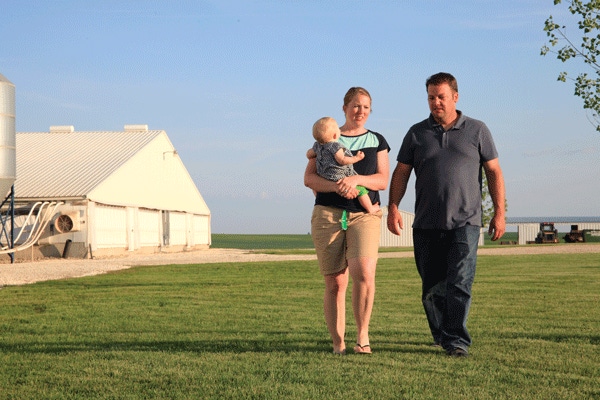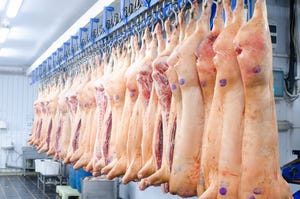Environmental Steward Award-Winning Iowa Farm Powered by Wind Energy
Into the Wind: Iowa farm sets a course for the future, powered by alternative energy and guided by stewardship.
September 19, 2013

The Russell Brothers LLC hog operation, a 7,200-head, wean-to-finish farm, sits high on a ridge in eastern Iowa’s Linn County. The wind always seems to blow here, so this family operation decided to use this natural phenomenon to its advantage.
“We’ve taken the bull by the horns as far as energy goes,” says Jason Russell, who provides day-to-day management of the site along with his wife, Sarah. “We built a wind turbine on this farm, and we have plans to explore other avenues, such as solar energy and anaerobic digesters, as additional sources of alternative energy.”
The Russell Brothers finishing site is located just north and east of Cedar Rapids, near Monticello, IA. The family has been farming in this area for 60 years, and decided to add the confinement hog operation as a way to keep the family farm sustainable for the future.
Brothers Dave, Dennis, Ralph, Moe and John Russell, along with Jason and Eric Russell (sons of Dennis) make up Russell Brothers LLC. The unit was built in 2003, and operates as a production partner with The Maschhoffs Inc.
The 50-kilowatt wind turbine, perched on a 140-ft.-tall tower adjacent to the finishers, has been a valuable addition. “We’ve saved a considerable amount of energy,” Jason Russell says. “It has replaced 60% to 80% of our power needs for any given year. The utility company has our site set up for ‘net metering,’ which means we basically bank the extra energy we create on windy days, and get credit for it on days when it’s not as windy.”
Federal and state incentives helped lower the risk of investing in the wind turbine, so the Russells decided to try the technology. “Uncle Moe was really happy the day it started running,” Jason continues. “He said it made him feel good about all those windy days he was doing chores as he grew up.”
Accounting for nutrients
The Russell Brothers operation shows how nutrient management can play a key role in tightly integrated crop and livestock enterprises. “We grow corn and soybeans — primarily corn at this point, because of economic reasons,” Jason says. “With the hog manure we have available, corn is simply more profitable to grow.”
Manure is pumped directly from deep pits under the finishers through a drag hose that supplies an applicator in the field. They use low-disturbance injectors and GPS guidance, which helps ensure the correct application rate, with no overlaps. The Russells also use a nitrification inhibitor, an additive that helps to lock in nitrogen, when applying manure.
Each year, the operation submits an official manure management plan, or an update, to the Iowa Department of Natural Resources. It defines land available for application and allowable agronomic rates. “We do a lot of recordkeeping, and we rely on precision agriculture to make sure we are getting the most value from the nutrients that are created by these barns,” Jason says. “The nutrients are worth a lot of money if they are used correctly.”
In order to make sure nutrients are properly used, Russell Brothers samples manure each year, and that information is then used to determine next year’s application rate. Every three years, soil samples are taken on 2.5-acre grids, so manure and other fertilizer nutrients can be placed with greater precision by basing rates on soil fertility and crop need.
The Russells also keep a tight rein on their nitrogen management. On all of their corn acres prior to harvest, from one to three weeks after corn reaches maturity, the Russells test stalk nitrate levels, which are geo-referenced to the spring soil samples they previously took to test for soil nitrate levels. “We learn more each year about how to manage nitrogen,” Jason says. “The tests allow us to develop a feel for how much nitrogen the corn actually needs, without overapplying the nutrient.”
The Russells also study yield data that are collected from their combine’s yield monitor. “This allows us to keep a bank account, so to speak, of nutrients applied and removed from the field,” Jason points out. “It gives us a snapshot of the nutrient profile of a field at any given time.”
Conservation concerns
Soil conservation is something that the Russell family takes seriously. “My grandfather and father are really good teachers on what conservation practices work, and they were early adopters of new technology within that realm,” Jason says.
There are a number of practices that the family follows to protect soil and water. The Russells cover any surface tile inlets before and during manure applications. Buffer strips along all water sources prevent manure or soil from reaching streams. Grassed waterways are used to prevent gullies and protect water quality. Contour farming and crop residues protect highly erodible land.
The Russells also installed a monitoring well located downhill from the hog confinement site. “All of the footing tiles that surround the manure pit are inside that ring of tile,” Jason says. “Any groundwater present will travel under that tile. If there were a manure leak, we would see it immediately coming into the grass waterway. It gives us extra peace of mind.”
Russell Brothers is located in the Silver Creek watershed, which ultimately feeds the Mississippi River. Another practice the family uses to protect the watershed is the use of cover crops.
Winter wheat is drilled in highly erodible fields with a no-till drill as a cover crop. The cover crop scavenges nitrogen available from the corn or soybean crop, or from fall-applied manure. Winter cereal cover crops are thought to sequester 30 to 50 lb. of N per acre. “The cover crop also prevents soil erosion and builds soil organic matter,” Jason adds.
Composting care
In July 2003, the Russells built a composting facility. The structure is an 80-by-32-ft. barn with five concrete bays housing the mortalities.
Recycled countertop substrate from a local factory provides the carbon source. The compost facility has a canopy to protect the compost bins from rain, and concrete floors to prevent leaching as it cures.
The Russells spread the finished compost as another fertilizer source, recycling nutrients on their farm and gaining soil organic matter. “It also boosts biosecurity,” Jason says. “It eliminates the need for a rendering truck to enter the site.”
Neighbor-focused
“At Russell Brothers, we’ve done a lot of landscaping and tree planting,” Jason points out. “It’s primarily for beautification purposes. But evergreens have a good smell, and they help filter dust and do a lot for odor control. They also provide food for wildlife and a place for them to live.”
The farm’s aesthetics and air quality help maintain a pleasant environment for neighbors as well. “Jason really tries to promote what we do here with the neighbors,” Sarah Russell says. “He tries to be very open and honest about what’s happening. I think that open communication allows everybody to feel involved.”
The Russells notify neighbors located close to application areas by sending out a letter explaining that special consideration will be given to weather conditions, special events and holidays when applying manure. Within the letter, they outline how, when, and why they apply manure.
To Jason and Sarah Russell, it’s just one more step that keeps the family farm focused on the future.
You might also like:
Utah Finishing Farm is Environmental Steward Winner
Manure Digester Means Nebraska Farm is Powered by Pigs
Ohio Finishing Operation is a Perfect Fit
Pork Checkoff Announces 2013 Pork Industry Environmental Stewards
You May Also Like
.png?width=300&auto=webp&quality=80&disable=upscale)


